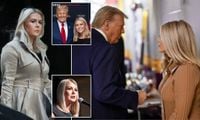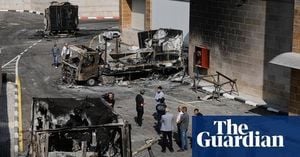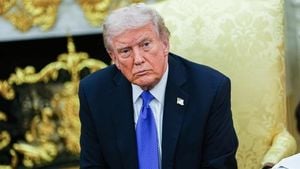On the morning of September 29, 2025, a quiet Sunday service at a Mormon church in Grand Blanc, Michigan, was shattered by a violent attack that left four people dead and as many as eight others injured. The alleged perpetrator, Thomas Jacob Sanford, was a former Marine and a known supporter of former President Donald Trump. Sanford, who was killed at the scene in a shootout with police, is accused of ramming his truck into the church before opening fire on congregants, according to multiple reports including NBC News and CBS News.
The aftermath of the attack has prompted a flurry of public debate, not only about the motives of the attacker but also about the response from the White House. On October 1, 2025, White House Press Secretary Karoline Leavitt addressed the incident during a press briefing covered live by NBC News. Leavitt, who has quickly become a recognizable figure in the administration, was also featured in coverage for her remarks regarding the government shutdown after Congress failed to reach a funding deal the previous evening. But it was her comments about the Michigan church shooting that drew the sharpest scrutiny.
During an appearance on Fox & Friends on September 30, Leavitt stated, “From what I understand, based on my conversations with the FBI director, all they know right now is that this was an individual who hated people of the Mormon faith.” She continued, “They are trying to understand more about this, how premeditated it was, how much planning went into it, whether he left a note. All of those questions are yet to be answered, but certainly will be answered by the FBI.”
Leavitt’s statement, while confirming that the FBI was actively investigating the attack’s circumstances and Sanford’s possible motives, notably omitted any mention of Sanford’s political leanings or his support for Donald Trump. This omission did not go unnoticed. Social media platforms quickly lit up with criticism, with users accusing Leavitt of sidestepping critical facts. One Threads user, Dale Wilbur, commented, “What a pathetic empty person she is. When she’s alone and looks in the mirror, how does she meet her own reflection?” Others pointed out the perceived hypocrisy in the administration’s narrative, with one remarking, “Funny how Mormons are suddenly accepted as Christians when MAGA can use their deaths for political propaganda.”
According to reporting by Shelby E., Sanford was pictured wearing a Trump T-shirt bearing the slogan “Make Liberals Cry Again,” a photo that quickly went viral after the attack. Despite this, Leavitt made no reference to Sanford’s political identity during her public remarks, focusing instead on his animosity toward the Mormon faith. Critics argued that this selective framing served to deflect attention from the uncomfortable reality that the attacker was a Trump supporter, a detail that could complicate the administration’s messaging.
Leavitt did, however, reference a social media post from President Trump following the shooting. “As the President rightfully put in his Truth Social yesterday, this appears to be yet another targeted attack on Christians, and the Trump administration is fully committed to not only investigating these crimes, but prosecuting them to the fullest extent of the law, but also working very hard to prevent them and to see if there’s red flags,” she said. The statement aligned with Trump’s ongoing narrative that Christians are increasingly under attack in America, a theme he and his supporters have often emphasized.
But the facts on the ground, as reported by The New York Times and CBS News, suggest a more complex story. Friends and acquaintances of Sanford told The New York Times that his rage was rooted not in a broad ideological crusade against Christians, but in a deeply personal grudge against the Church of Jesus Christ of Latter-day Saints. This grudge, they said, dated back to a painful breakup with a Mormon woman in Utah more than a decade ago. The relationship’s end reportedly left Sanford in “rough shape,” fueling years of obsessive animosity toward the church. He was known to rant that “Mormons are the Antichrist,” even disrupting a best friend’s wedding with tirades about the faith. As recently as the week before the attack, Sanford reportedly unloaded on a canvassing politician about his ex and the church’s demands.
One woman who rented a room to Sanford recounted, “He wasn’t so sure that he wanted to become a member of the church. But he really wanted to be with this woman.” CBS News added that local Grand Blanc politician Kris Johns had a conversation with Sanford just a week before the attack, during which Sanford ranted about how church members “believe they’re above Jesus.”
Sanford’s background further complicates the narrative. The 40-year-old served in the Marine Corps from 2004 to 2008, including a deployment to Fallujah, Iraq, in 2007, where he specialized in repairing and maintaining military vehicles. Investigators have yet to confirm a definitive motive for the attack, and the FBI is reportedly examining whether the act was premeditated, how much planning went into it, and whether Sanford left behind a note explaining his actions.
The debate over the status of Mormons within the broader Christian community also resurfaced in the wake of the attack. While Mormons generally consider themselves Christians, their beliefs differ in several ways from mainstream Christian denominations. For instance, Mormons believe in the existence of many gods and hold that Jesus was also a God, whereas traditional Christian doctrine asserts that there is only one God in the form of the Holy Trinity. This longstanding theological debate has often been a source of tension between Mormons and other Christian groups, a tension that was highlighted in the aftermath of the Grand Blanc tragedy.
As the investigation continues, the White House’s handling of the incident remains under the microscope. Critics from across the political spectrum have weighed in, with some accusing the administration of using the attack for political gain, while others argue that the focus should remain on preventing future tragedies regardless of the attacker’s affiliations. The incident has also reignited discussions about mental health, the role of personal grievances in acts of mass violence, and the responsibilities of public officials in shaping the national conversation after such events.
For now, the Grand Blanc community is left to mourn the loss of life and grapple with the shock of violence in a place of worship. As new details emerge, both the facts of the case and the narratives constructed around them will continue to shape public understanding and political debate in the weeks to come.





